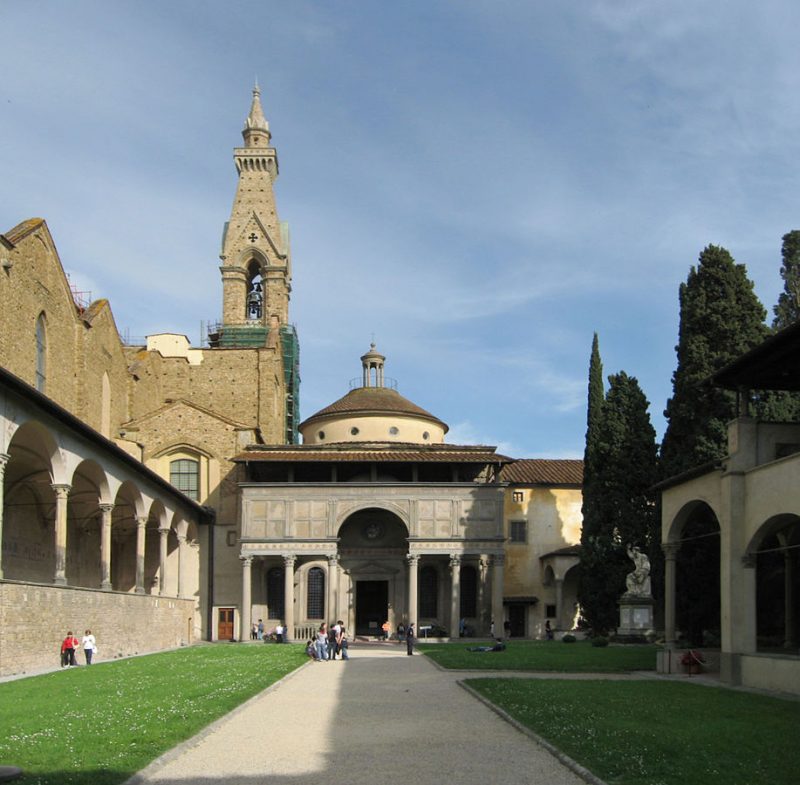The Pazzi Chapel is located in the first cloister of the Church of Santa Croce in Florence. A symbol of the early Renaissance style and one of Florence’s icons, it’s an enchanting place, whose geometric proportions transmit an almost spiritual quality.
The design and the construction stages of the Pazzi Chapel have been much debated. For centuries it was attributed to Filippo Brunelleschi, but scholars have speculated that he may only have provided the initial designs. (Brunelleschi died in 1446, long before the building was finished). Whoever was responsible for the chapel, it is a splendid example of the Renaissance search for harmony in architecture that is well worth visiting and admiring.
=> 7 Unmissable Museums to visit in Florence

Pazzi Chapel – An architectural highlight of Florence
Around 1430, the rich Florentine banker Andrea de’ Pazzi commissioned Filippo Brunelleschi to build a chapel in the Santa Croce complex. The chapel was to function as a burial place for his family and also as a Chapter House – a meeting room for the monks. The construction suffered many interruptions and still hadn’t been concluded by 1478, when the Pazzi family fell in disgrace for conspiring against the ruling Medici.
Many artists contributed to this splendid chapel making it an extraordinary example of Early Renaissance style. While the chapel’s interior has a distinctive Brunelleschian look (you’ll see many similarities if you visit the Old Sacristy in San Lorenzo Church in Florence, which was designed by the same architect), the portico has been attributed by critics to Giuliano da Maiano, Rossellino or Michelozzo.
♥ Are you an art passionate? Check out the Best Churches to visit in Florence. And the most famous Renaissance masterpieces you can admire in the city.

GEOMETRY AND BEAUTY. LESSONS FROM THE CLASSICS
When the Pazzi Chapel appeared, a new architectural style was taking shape in Florence. Think how different this is from a Gothic church, with its irregular and convoluted shapes. The architects, having studied classical architecture and learned from the ancient Romans to use columns, arches and domes, they use these features to create a rational harmony. The new keywords for this architectural style? Composed, rational and geometric.
The Pazzi Chapel and the distinctive geometry of the Renaissance
THE INTERIOR
Brunelleschi was one of those artists who spent time in Rome studying ancient buildings, and the Pantheon became his icon of style. He reproduced its design when planning the Cathedral’s dome in Florence, and used the classical forms that he had admired in Rome in his works. Geometric clarity became the most distinctive feature of his style, and the Pazzi Chapel’s interior is a perfect example of harmonic proportion.
The first thing you notice when entering the chapel is how perfectly and rationally organised it is. Its rectangular shape has a central square surmounted by a hemispherical dome. The architectural elements are clearly defined by the use of grey stone (pietra serena). The dome lets the light filter through the windows along its perimeter, giving the space elegance and measure. The stone bench that runs along the walls served as sitting space for the monks.
→ See Florence’s top attractions and 20 amazing experiences to have during your stay!

Photo by Gryffindor
GLAZED TERRACOTTA ROUNDELS BY DELLA ROBBIA
The decoration of the chapel has a functional feel. The roundels are amongst the best creations of Luca Della Robbia, their blues stand out against the white and grey of the walls. The one placed at the four sides of the dome are most likely designed by Brunelleschi, and underneath them you see the coat of arms of the Pazzi family with two dolphins. Brunelleschi decided not to have an altar piece so as to keep the decoration to a minimum. The dome of the apse has a simple fresco of the sky over Florence.
THE PORTICO
The portico at the entrance constitutes the facade of the chapel. It has six Corinthian columns and a centre raised as a triumphal arch. As you walk under it you can see the elaborate and vivid decoration inside the dome created by Luca della Robbia in glazed terracotta. Underneath there’s a roundel by the same artist that depicts Saint Andrea, patron saint of Andrea de’ Pazzi who was paying for the chapel. The works weren’t finished at the time of the Pazzi Conspiracy in 1478.
Did you know? The Pazzi conspiracy
The construction work was still underway when a tragic incident shocked Florence. The episode has gone done in history as the “Congiura dei Pazzi” or “Pazzi Conspiracy”, as the Pazzi family was involved in organising the murder of Lorenzo il Magnifico de Medici and his brother Giuliano. It happened on the 26th April 1478, when the two brothers, attending mass in Florence Cathedral, were attacked by supporters of the Pazzi with the aid of the Pope. The Pazzi wanted to stop the Medici hegemony over Florence, but though they managed to kill Giuliano, Lorenzo escaped and took a terrible revenge against them.
=> Discover some interesting facts about the Medici family, and their palaces in Florence.
=> 8 Good Reasons to visit the Uffizi Gallery in Florence!
Art lover? => Check out the Beautiful Frescoes by Giotto in Santa Croce Church and Why the Competition Panels for Florence Baptistry mark a special moment in art history.
Discover the fascinating Boboli Gardens Grottoes.

